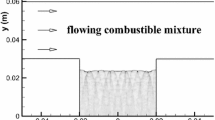Abstract
Propagation of a plane detonation wave in a stoichiometric mixture of a gas and aluminum particles in a plane channel with a linear expansion section is studied by methods of numerical simulation. The slope of the wall is varied from 15 to 60°. The basic regimes of detonation propagation are analyzed: supercritical (without detonation failure), critical (with partial failure and re-initiation), and subcritical (with complete separation of the shock front and combustion front and with detonation failure). The detonation configuration formed in the expanding section can be a cellular structure with large differences in cell sizes at large angles of expansion or a close-to-uniform structure at the wall angle of 15°.
Similar content being viewed by others
References
A. V. Fedorov, Yu. V. Kratova, and T. A. Khmel’, “Numerical Study of Shock-Wave Diffraction in Variable-Section Channels in Gas Suspensions,” Fiz. Goreniya Vzryva 44 (1), 85–95 (2008) [Combust., Expl., Shock Waves 44 (1), 76–85 (2008)].
A. V. Fedorov, T. A. Khmel, and Y. V. Kratova, “Shock and Detonation Wave Diffraction at a Sudden Expansion in Gas–Particle Mixtures,” Shock Waves 18, 280–290 (2008).
Yu. V. Kratova, A. V. Fedorov, and T. A. Khmel’, “Diffraction of a Plane Detonation Wave on a Back-Facing Step in a Gas Suspension,” Fiz. Goreniya Vzryva 45 (5), 95–107 (2009) [Combust., Expl., Shock Waves 45 (5), 591–602 (2009)].
A. V. Fedorov, T. A. Khmel, and Y. V. Kratova, “Cellular Detonation Diffraction in Gas–Particle Mixtures,” Shock Waves, 20 (6), 509–519 (2010).
Yu. V. Kratova, A. V. Fedorov, and T. A. Khmel’, “Propagation of Detonation Waves in Gas Suspensions in Channels with a Backward-Facing Step,” Fiz. Goreniya Vzryva 47 (1), 80–91 (2011) [Combust., Expl., Shock Waves 47 (1), 70–80 (2011)].
Yu. V. Kratova, A. V. Fedorov, and T. A. Khmel’, “Specific Features of Cellular Detonation in Polydisperse Suspensions of Aluminum Particles in a Gas,” Fiz. Goreniya Vzryva 47 (5), 85–94 (2011) [Combust., Expl., Shock Waves 47 (5), 572–580 (2011)].
A. V. Fedorov, V. M. Fomin, and T. M. Khmel’, Wave Processes in Gas Suspensions of Metal Particles (Parallel, Novosibirsk, 2015) [in Russian].
Yu. V. Kratova, T. A. Khmel’, and A. V. Fedorov, “Axisymmetric Expanding Heterogeneous Detonation in Gas Suspensions of Aluminum Particles,” Fiz. Goreniya Vzryva 52 (1), 84–95 (2016) [Combust., Expl., Shock Waves 52 (1), 74–84 (2016)].
A. V. Fedorov, V. M. Fomin, and Yu. A. Gosteev, Dynamics and Ignition of Gas Suspensions (Izd. NGTU, Novosibirsk, 2006) [in Russian].
A. V. Fedorov and T. A. Khmel’, “Characteristics and Criteria of Ignition of Suspensions of Aluminum Particles in Detonation Processes,” Fiz. Goreniya Vzryva 48 (2), 76–88 (2012) [Combust., Expl., Shock Waves 48 (2), 191–202 (2012)].
V. V. Mitrofanov and R. I. Soloukhin, “On the Diffraction of a Multifront Detonation Wave,” Dokl. Akad. Nauk SSSR 159 (5), 1003–1006 (1964).
A. A. Vasil’ev, “Critical Conditions for Initiation of Cylindrical Multifront Detonation,” Fiz. Goreniya Vzryva 34 (2), 114–120 (1998) [Combust., Expl., Shock Waves 34 (2), 220–225 (1998)].
A. A. Vasil’ev, V. V. Mitrofanov, and M. E. Topchiyan, “Detonation Waves in Gases,” Fiz. Goreniya Vzryva 23 (5), 109–131 (1987) [Combust., Expl., Shock Waves 23 (5), 605–623 (1987)].
G. O. Thomas and R. L. Williams, “Detonation Interaction withWedges and Bends,” ShockWaves 11, 481–492 (2002).
C. Conrad, S. R. Saretto, S.-Y. Lee, and R. J. Santoro, “Overdriven Detonation Wave Transition in a Gradual Area Expansion for Multicycle PDE Application,” in Pulse and Continuous Detonation Propulsion, Ed. by G. Roy and S. Frolov (Torus Press, Moscow, 2006), pp. 273–286.
Q. Qing, C. K. Boo, D. Hua-Shu, and M. T. Her, “The Evolution of a Detonation Wave in a Variable Cross-Sectional Chamber,” Shock Waves 18, 213–233 (2008).
B. Khasainov, H. N. Presles, D. Desbordes, P. Demontis, and P. Vidal, “Detonation Diffraction from Circular Tubes to Cones,” Shock Waves 14, 187–192 (2005).
A. A. Vasil’ev and A. V. Trotsyuk, “Experimental Investigation and Numerical Simulation of an Expanding Multifront Detonation Wave,” Fiz. Goreniya Vzryva 39 (1), 92–103 (2003) [Combust., Expl., Shock Waves 39 (1), 80–90 (2003)].
A. V. Fedorov, “Structure of the Heterogeneous Detonation of Aluminum Particles Dispersed in Oxygen,” Fiz. Goreniya Vzryva 28 (3), 72–83 (1992) [Combust., Expl., Shock Waves 28 (3), 277–286 (1992)].
W. A. Strauss, “Investigation of the Detonation of Aluminum Powder-Oxygen Mixtures,” AIAA J. 6 (9), 1753–1761 (1968).
A. V. Fedorov and T. A. Khmel’, “Numerical Technologies for Studying Heterogeneous Detonation in Gas Suspensions,” Mat. Model. 18 (8), 49–63 (2006).
G. V. Bazhenova, Unsteady Interactions of Shock Waves and Detonation Waves in Gases (Nauka, Moscow, 1986) [in Russian].
H. O. Barthel, “Predicted Spacings in Hydrogen–Oxygen–Argon Detonations,” Phys. Fluids 17 (8), 1547–1553 (1974).
A. V. Fedorov and T. A. Khmel’, “Numerical Simulation of Formation of Cellular Heterogeneous Detonation of Aluminum Particles in Oxygen,” Fiz. Goreniya Vzryva 41 (4), 84–98 (2005) [Combust., Expl., Shock Waves 41 (4), 435–448 (2005)].
A. V. Fedorov and T. A. Khmel’, “Formation and Degeneration of Cellular Detonation in Bidisperse Gas Suspensions of Aluminum Particles,” Fiz. Goreniya Vzryva 44 (3), 109–120 (2008) [Combust., Expl., Shock Waves 44 (3), 343–353 (2008)].
Author information
Authors and Affiliations
Corresponding author
Additional information
Original Russian Text © A.V. Fedorov, T.A. Khmel’, S.A. Lavruk.
Published in Fizika Goreniya i Vzryva, Vol. 53, No. 5, pp. 104–114, September–October, 2017.
Rights and permissions
About this article
Cite this article
Fedorov, A.V., Khmel’, T.A. & Lavruk, S.A. Exit of a heterogeneous detonation wave into a channel with linear expansion. I. Propagation regimes. Combust Explos Shock Waves 53, 585–595 (2017). https://doi.org/10.1134/S0010508217050136
Received:
Published:
Issue Date:
DOI: https://doi.org/10.1134/S0010508217050136



